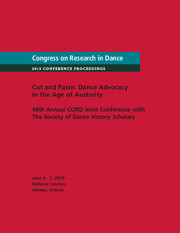Article contents
A Creative Ethos: Teaching and Learning at the Cloud Gate Dance School in Taiwan
Published online by Cambridge University Press: 04 January 2013
Abstract
Theory suggests that prescription should be detrimental to creativity. The Cloud Gate Dance School has highly structured and detailed curricula and pedagogical practices where the meeting of specific course and individual lesson objectives are regarded as essential. Yet, personal creativity in activities is stressed by the school's leaders and teachers, both for teachers and students. This paper considers the construction of creativity in the specific context and how it is underpinned by the school's ethos. It is based on observations of studio practice, discussions with teachers and other staff, and analysis of printed curricula documentation.
- Type
- Research Article
- Information
- Copyright
- Copyright © The Author(s) 2009
References
Works Cited
- 2
- Cited by


